Financial Accounting Assignment: Analysis of Company Liquidations
VerifiedAdded on 2021/06/14
|13
|3105
|62
Report
AI Summary
This financial accounting report examines the liquidation of companies, focusing on Australian examples such as ABC Learning, One Tel, and HIH Insurance. It delves into the reasons behind these liquidations, including the inability to manage debt, unethical accounting practices, and deficient corporate governance. The report highlights how factors such as misleading financial information, inadequate internal controls, and overvalued acquisitions contributed to the downfall of these companies. It further analyzes the roles of auditors and management in these failures. The report concludes with recommendations to prevent similar situations in the future, emphasizing the importance of ethical conduct, effective financial management, and strong corporate governance. The report provides a detailed analysis of the liquidation process, the key contributing factors, and potential strategies to mitigate the risks associated with company failures.

FINANCIAL
ACCOUNTING
ASSIGNMENT
ACCOUNTING
ASSIGNMENT
Paraphrase This Document
Need a fresh take? Get an instant paraphrase of this document with our AI Paraphraser
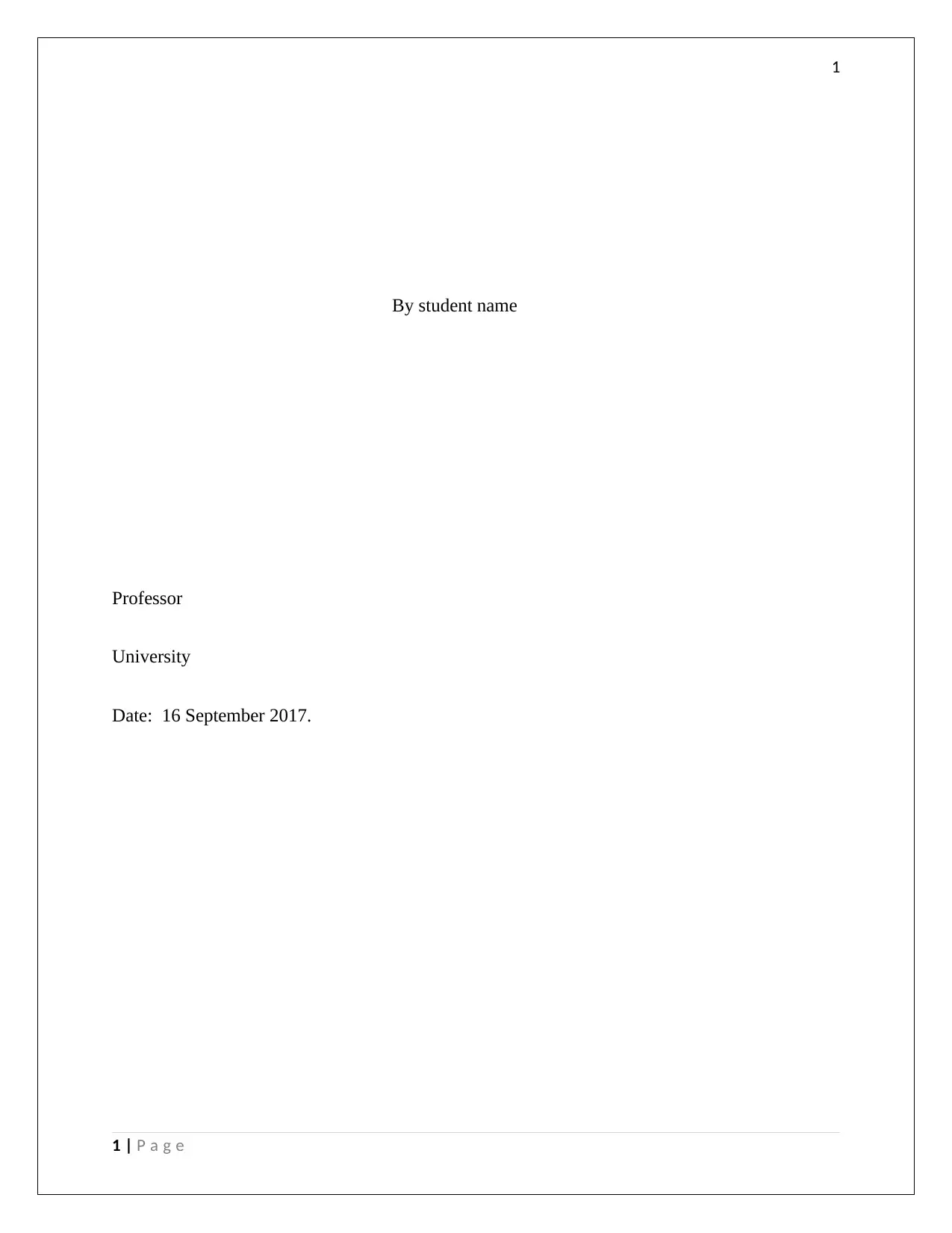
1
By student name
Professor
University
Date: 16 September 2017.
1 | P a g e
By student name
Professor
University
Date: 16 September 2017.
1 | P a g e
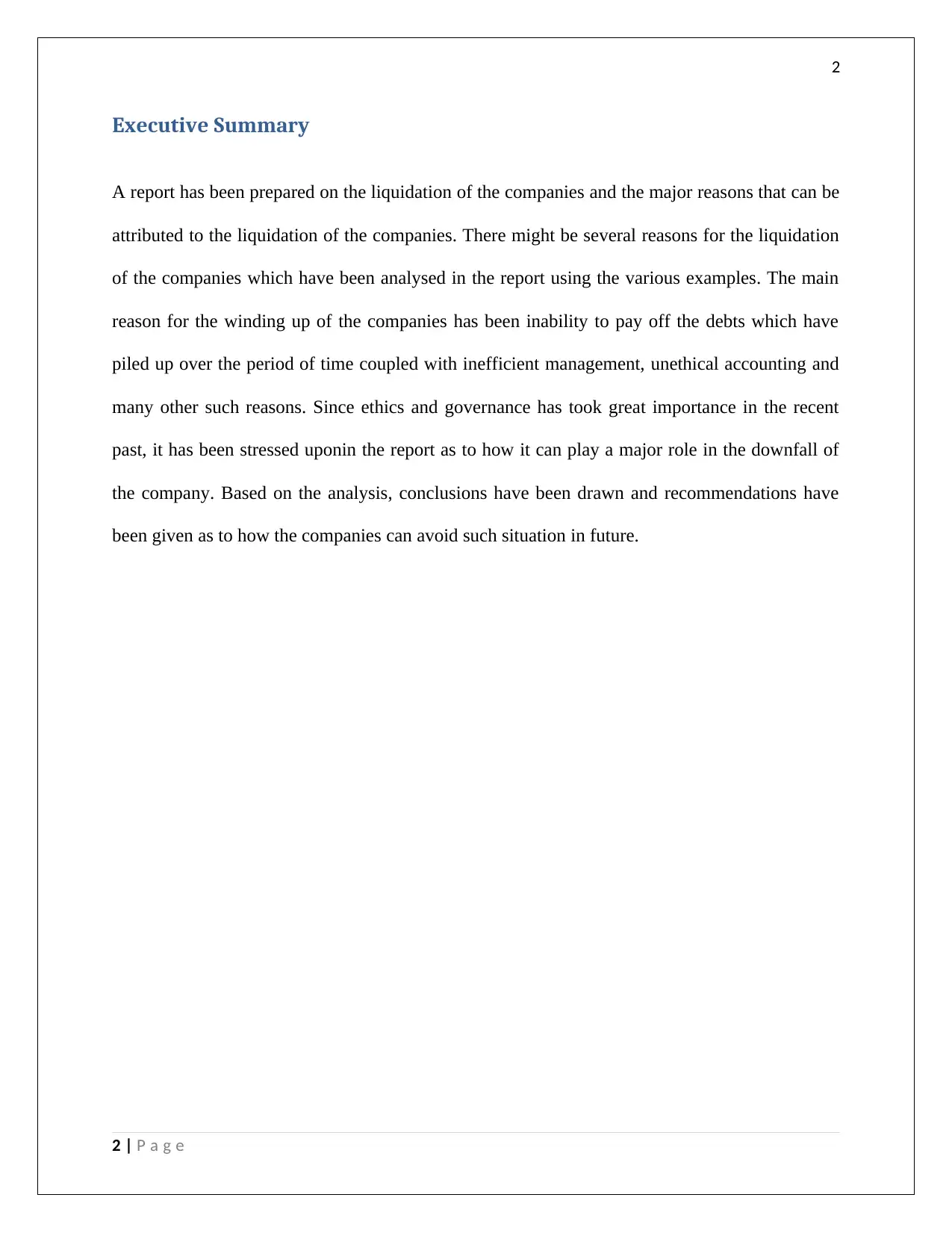
2
Executive Summary
A report has been prepared on the liquidation of the companies and the major reasons that can be
attributed to the liquidation of the companies. There might be several reasons for the liquidation
of the companies which have been analysed in the report using the various examples. The main
reason for the winding up of the companies has been inability to pay off the debts which have
piled up over the period of time coupled with inefficient management, unethical accounting and
many other such reasons. Since ethics and governance has took great importance in the recent
past, it has been stressed uponin the report as to how it can play a major role in the downfall of
the company. Based on the analysis, conclusions have been drawn and recommendations have
been given as to how the companies can avoid such situation in future.
2 | P a g e
Executive Summary
A report has been prepared on the liquidation of the companies and the major reasons that can be
attributed to the liquidation of the companies. There might be several reasons for the liquidation
of the companies which have been analysed in the report using the various examples. The main
reason for the winding up of the companies has been inability to pay off the debts which have
piled up over the period of time coupled with inefficient management, unethical accounting and
many other such reasons. Since ethics and governance has took great importance in the recent
past, it has been stressed uponin the report as to how it can play a major role in the downfall of
the company. Based on the analysis, conclusions have been drawn and recommendations have
been given as to how the companies can avoid such situation in future.
2 | P a g e
⊘ This is a preview!⊘
Do you want full access?
Subscribe today to unlock all pages.

Trusted by 1+ million students worldwide
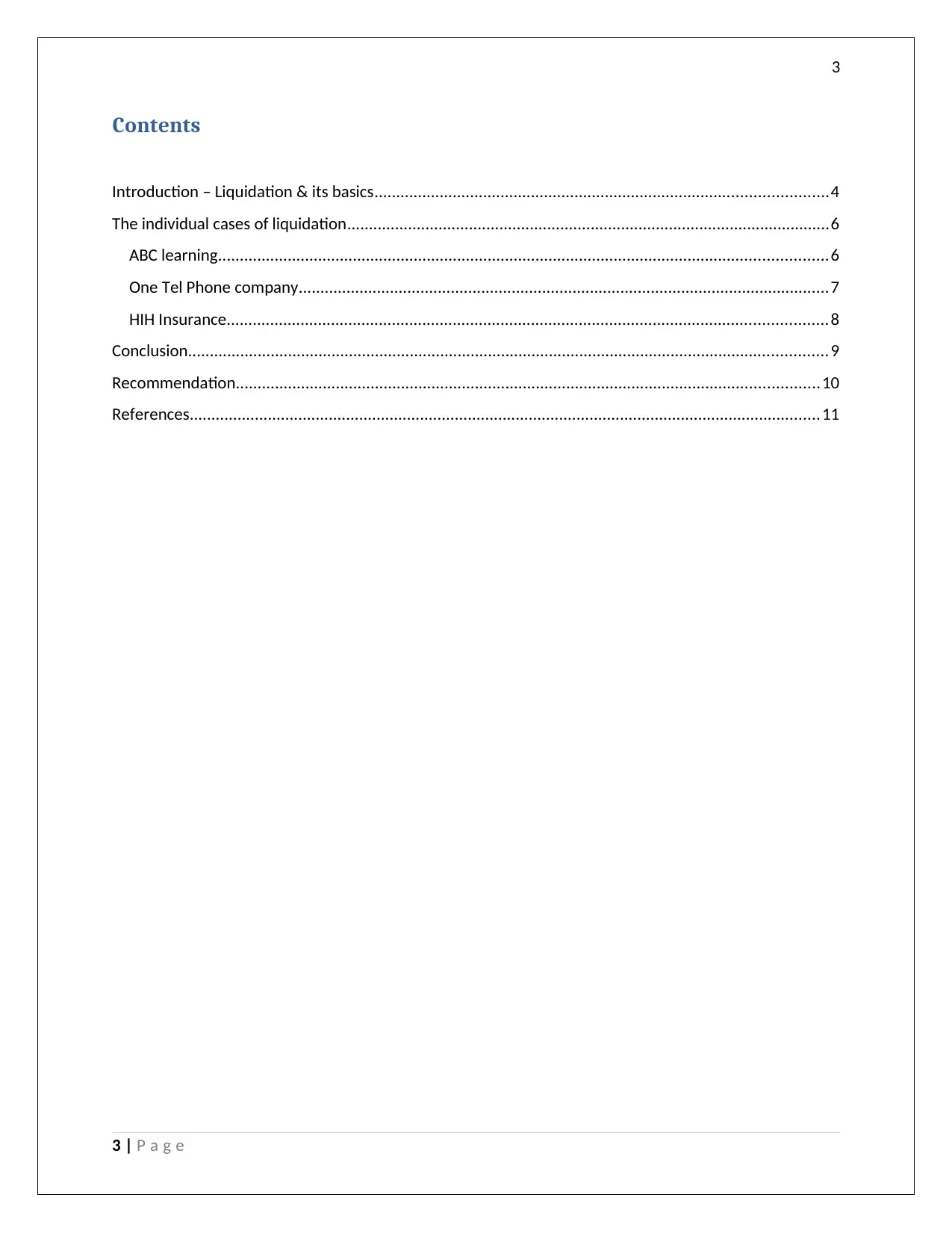
3
Contents
Introduction – Liquidation & its basics........................................................................................................4
The individual cases of liquidation...............................................................................................................6
ABC learning............................................................................................................................................6
One Tel Phone company..........................................................................................................................7
HIH Insurance..........................................................................................................................................8
Conclusion...................................................................................................................................................9
Recommendation......................................................................................................................................10
References.................................................................................................................................................11
3 | P a g e
Contents
Introduction – Liquidation & its basics........................................................................................................4
The individual cases of liquidation...............................................................................................................6
ABC learning............................................................................................................................................6
One Tel Phone company..........................................................................................................................7
HIH Insurance..........................................................................................................................................8
Conclusion...................................................................................................................................................9
Recommendation......................................................................................................................................10
References.................................................................................................................................................11
3 | P a g e
Paraphrase This Document
Need a fresh take? Get an instant paraphrase of this document with our AI Paraphraser
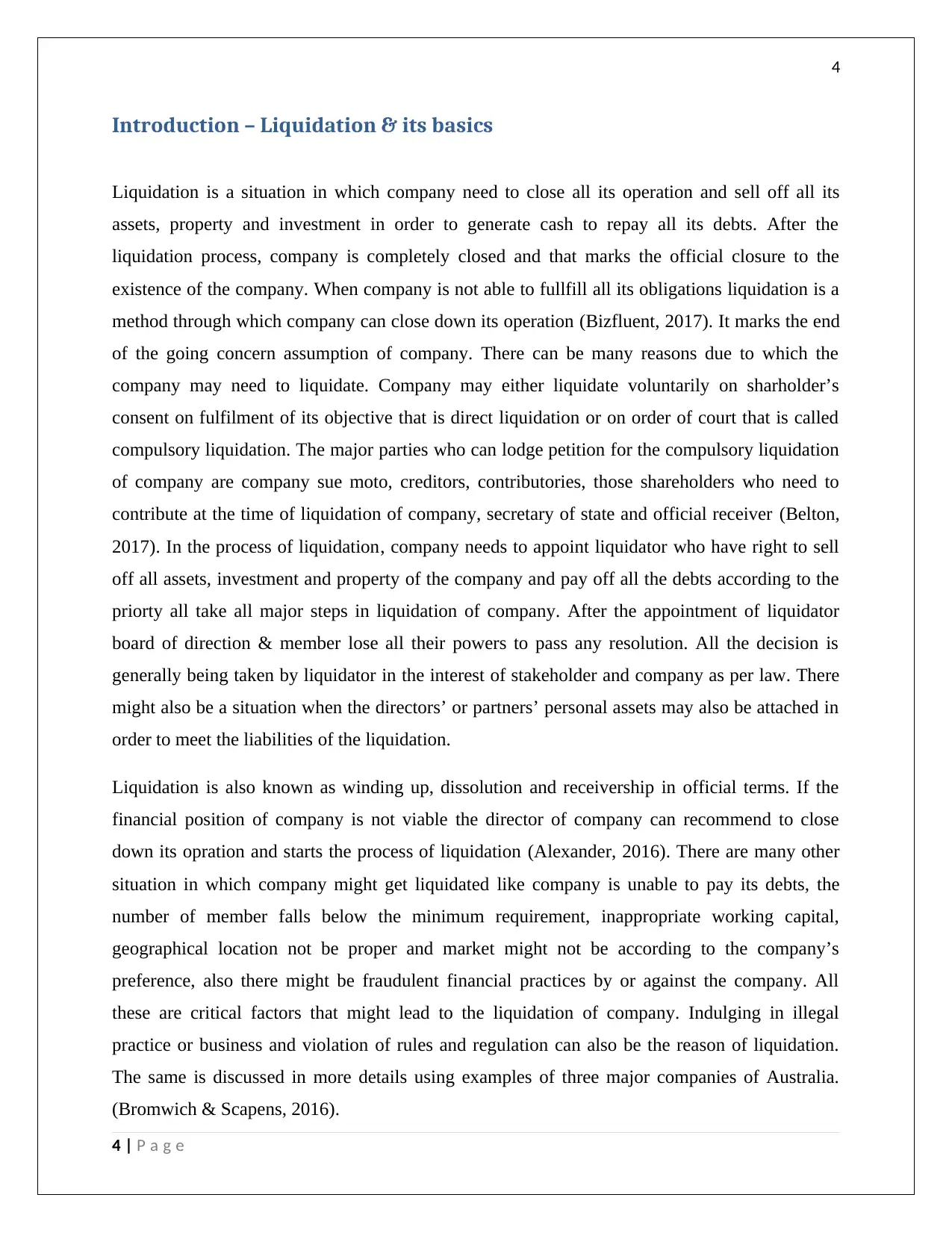
4
Introduction – Liquidation & its basics
Liquidation is a situation in which company need to close all its operation and sell off all its
assets, property and investment in order to generate cash to repay all its debts. After the
liquidation process, company is completely closed and that marks the official closure to the
existence of the company. When company is not able to fullfill all its obligations liquidation is a
method through which company can close down its operation (Bizfluent, 2017). It marks the end
of the going concern assumption of company. There can be many reasons due to which the
company may need to liquidate. Company may either liquidate voluntarily on sharholder’s
consent on fulfilment of its objective that is direct liquidation or on order of court that is called
compulsory liquidation. The major parties who can lodge petition for the compulsory liquidation
of company are company sue moto, creditors, contributories, those shareholders who need to
contribute at the time of liquidation of company, secretary of state and official receiver (Belton,
2017). In the process of liquidation, company needs to appoint liquidator who have right to sell
off all assets, investment and property of the company and pay off all the debts according to the
priorty all take all major steps in liquidation of company. After the appointment of liquidator
board of direction & member lose all their powers to pass any resolution. All the decision is
generally being taken by liquidator in the interest of stakeholder and company as per law. There
might also be a situation when the directors’ or partners’ personal assets may also be attached in
order to meet the liabilities of the liquidation.
Liquidation is also known as winding up, dissolution and receivership in official terms. If the
financial position of company is not viable the director of company can recommend to close
down its opration and starts the process of liquidation (Alexander, 2016). There are many other
situation in which company might get liquidated like company is unable to pay its debts, the
number of member falls below the minimum requirement, inappropriate working capital,
geographical location not be proper and market might not be according to the company’s
preference, also there might be fraudulent financial practices by or against the company. All
these are critical factors that might lead to the liquidation of company. Indulging in illegal
practice or business and violation of rules and regulation can also be the reason of liquidation.
The same is discussed in more details using examples of three major companies of Australia.
(Bromwich & Scapens, 2016).
4 | P a g e
Introduction – Liquidation & its basics
Liquidation is a situation in which company need to close all its operation and sell off all its
assets, property and investment in order to generate cash to repay all its debts. After the
liquidation process, company is completely closed and that marks the official closure to the
existence of the company. When company is not able to fullfill all its obligations liquidation is a
method through which company can close down its operation (Bizfluent, 2017). It marks the end
of the going concern assumption of company. There can be many reasons due to which the
company may need to liquidate. Company may either liquidate voluntarily on sharholder’s
consent on fulfilment of its objective that is direct liquidation or on order of court that is called
compulsory liquidation. The major parties who can lodge petition for the compulsory liquidation
of company are company sue moto, creditors, contributories, those shareholders who need to
contribute at the time of liquidation of company, secretary of state and official receiver (Belton,
2017). In the process of liquidation, company needs to appoint liquidator who have right to sell
off all assets, investment and property of the company and pay off all the debts according to the
priorty all take all major steps in liquidation of company. After the appointment of liquidator
board of direction & member lose all their powers to pass any resolution. All the decision is
generally being taken by liquidator in the interest of stakeholder and company as per law. There
might also be a situation when the directors’ or partners’ personal assets may also be attached in
order to meet the liabilities of the liquidation.
Liquidation is also known as winding up, dissolution and receivership in official terms. If the
financial position of company is not viable the director of company can recommend to close
down its opration and starts the process of liquidation (Alexander, 2016). There are many other
situation in which company might get liquidated like company is unable to pay its debts, the
number of member falls below the minimum requirement, inappropriate working capital,
geographical location not be proper and market might not be according to the company’s
preference, also there might be fraudulent financial practices by or against the company. All
these are critical factors that might lead to the liquidation of company. Indulging in illegal
practice or business and violation of rules and regulation can also be the reason of liquidation.
The same is discussed in more details using examples of three major companies of Australia.
(Bromwich & Scapens, 2016).
4 | P a g e

5
5 | P a g e
5 | P a g e
⊘ This is a preview!⊘
Do you want full access?
Subscribe today to unlock all pages.

Trusted by 1+ million students worldwide
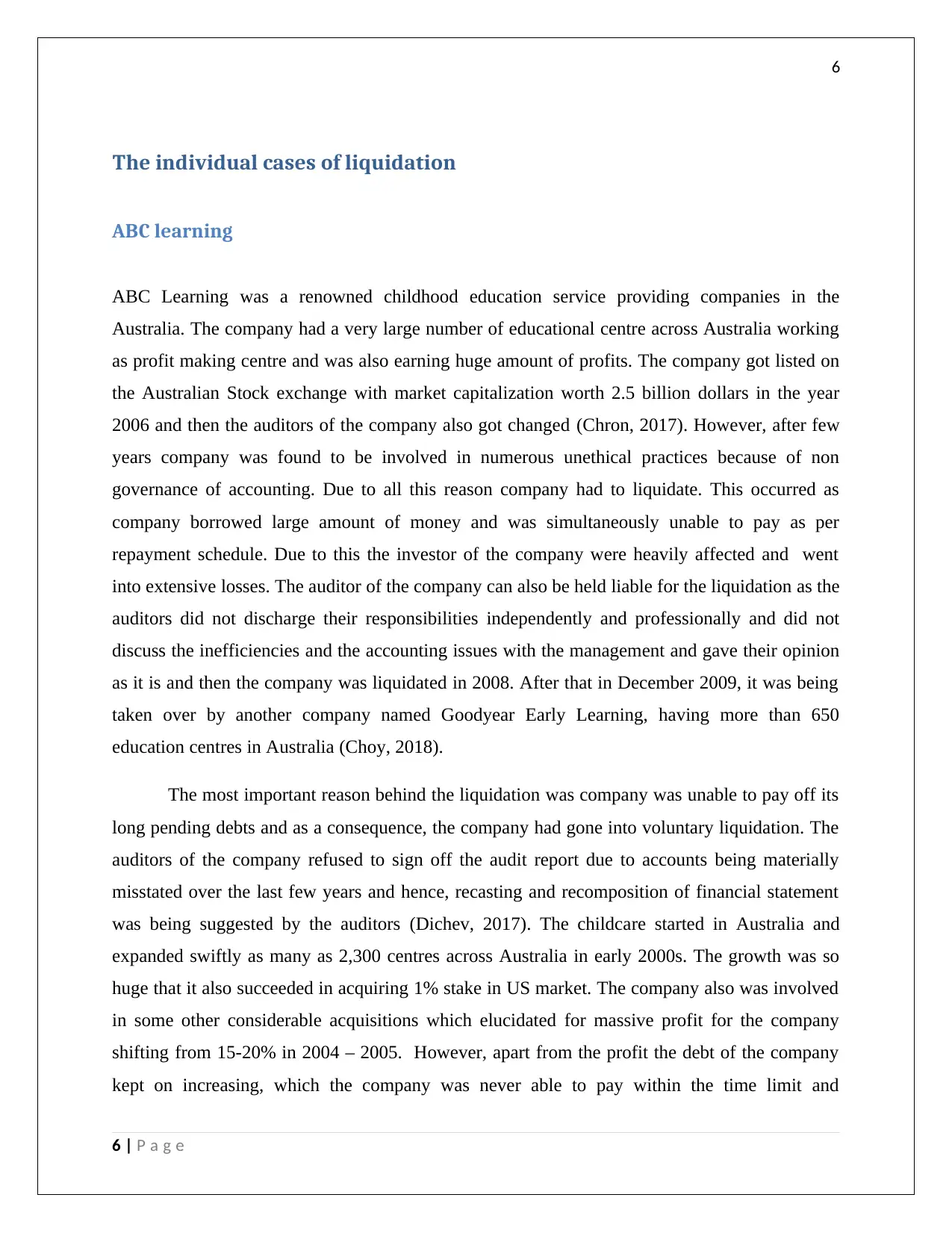
6
The individual cases of liquidation
ABC learning
ABC Learning was a renowned childhood education service providing companies in the
Australia. The company had a very large number of educational centre across Australia working
as profit making centre and was also earning huge amount of profits. The company got listed on
the Australian Stock exchange with market capitalization worth 2.5 billion dollars in the year
2006 and then the auditors of the company also got changed (Chron, 2017). However, after few
years company was found to be involved in numerous unethical practices because of non
governance of accounting. Due to all this reason company had to liquidate. This occurred as
company borrowed large amount of money and was simultaneously unable to pay as per
repayment schedule. Due to this the investor of the company were heavily affected and went
into extensive losses. The auditor of the company can also be held liable for the liquidation as the
auditors did not discharge their responsibilities independently and professionally and did not
discuss the inefficiencies and the accounting issues with the management and gave their opinion
as it is and then the company was liquidated in 2008. After that in December 2009, it was being
taken over by another company named Goodyear Early Learning, having more than 650
education centres in Australia (Choy, 2018).
The most important reason behind the liquidation was company was unable to pay off its
long pending debts and as a consequence, the company had gone into voluntary liquidation. The
auditors of the company refused to sign off the audit report due to accounts being materially
misstated over the last few years and hence, recasting and recomposition of financial statement
was being suggested by the auditors (Dichev, 2017). The childcare started in Australia and
expanded swiftly as many as 2,300 centres across Australia in early 2000s. The growth was so
huge that it also succeeded in acquiring 1% stake in US market. The company also was involved
in some other considerable acquisitions which elucidated for massive profit for the company
shifting from 15-20% in 2004 – 2005. However, apart from the profit the debt of the company
kept on increasing, which the company was never able to pay within the time limit and
6 | P a g e
The individual cases of liquidation
ABC learning
ABC Learning was a renowned childhood education service providing companies in the
Australia. The company had a very large number of educational centre across Australia working
as profit making centre and was also earning huge amount of profits. The company got listed on
the Australian Stock exchange with market capitalization worth 2.5 billion dollars in the year
2006 and then the auditors of the company also got changed (Chron, 2017). However, after few
years company was found to be involved in numerous unethical practices because of non
governance of accounting. Due to all this reason company had to liquidate. This occurred as
company borrowed large amount of money and was simultaneously unable to pay as per
repayment schedule. Due to this the investor of the company were heavily affected and went
into extensive losses. The auditor of the company can also be held liable for the liquidation as the
auditors did not discharge their responsibilities independently and professionally and did not
discuss the inefficiencies and the accounting issues with the management and gave their opinion
as it is and then the company was liquidated in 2008. After that in December 2009, it was being
taken over by another company named Goodyear Early Learning, having more than 650
education centres in Australia (Choy, 2018).
The most important reason behind the liquidation was company was unable to pay off its
long pending debts and as a consequence, the company had gone into voluntary liquidation. The
auditors of the company refused to sign off the audit report due to accounts being materially
misstated over the last few years and hence, recasting and recomposition of financial statement
was being suggested by the auditors (Dichev, 2017). The childcare started in Australia and
expanded swiftly as many as 2,300 centres across Australia in early 2000s. The growth was so
huge that it also succeeded in acquiring 1% stake in US market. The company also was involved
in some other considerable acquisitions which elucidated for massive profit for the company
shifting from 15-20% in 2004 – 2005. However, apart from the profit the debt of the company
kept on increasing, which the company was never able to pay within the time limit and
6 | P a g e
Paraphrase This Document
Need a fresh take? Get an instant paraphrase of this document with our AI Paraphraser
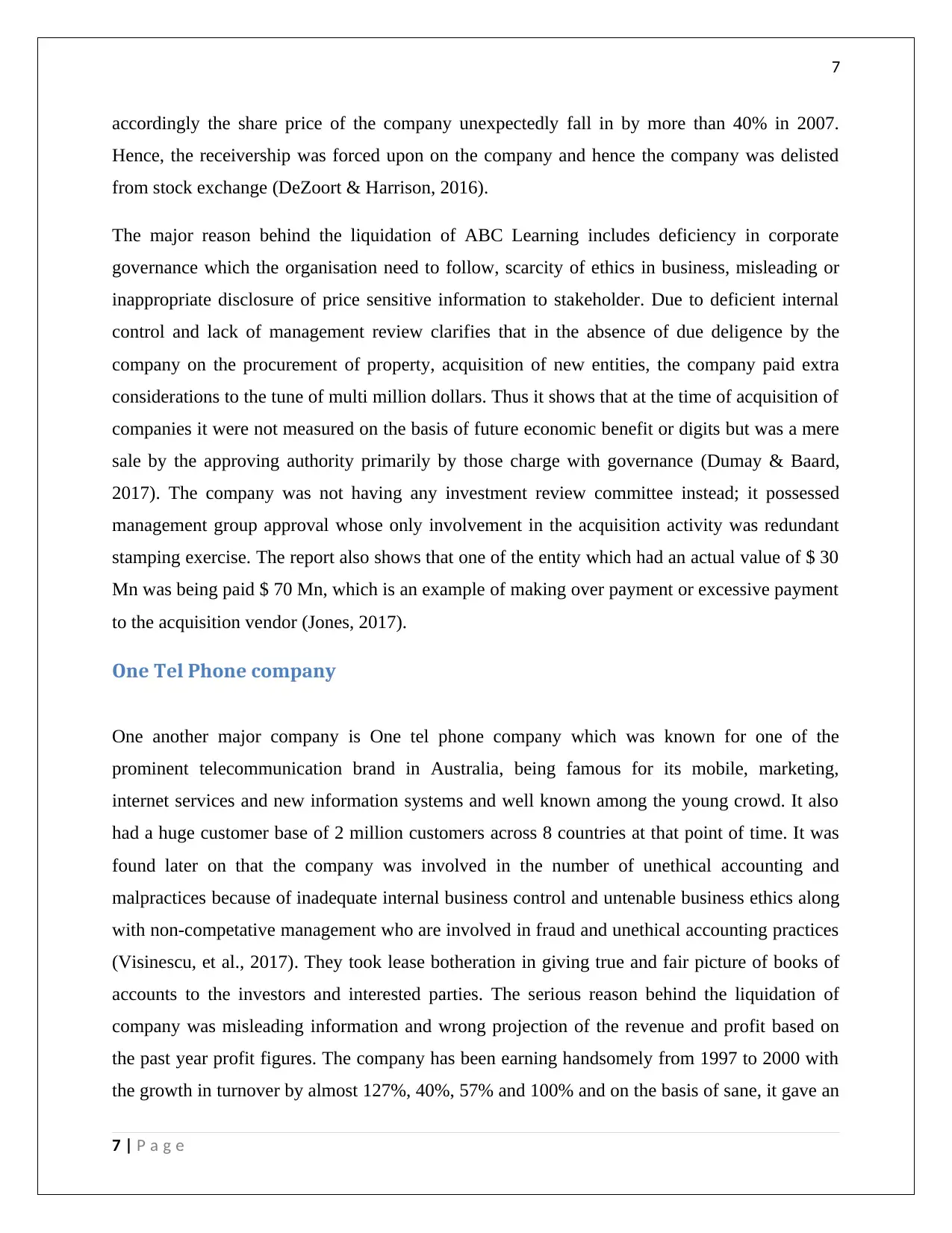
7
accordingly the share price of the company unexpectedly fall in by more than 40% in 2007.
Hence, the receivership was forced upon on the company and hence the company was delisted
from stock exchange (DeZoort & Harrison, 2016).
The major reason behind the liquidation of ABC Learning includes deficiency in corporate
governance which the organisation need to follow, scarcity of ethics in business, misleading or
inappropriate disclosure of price sensitive information to stakeholder. Due to deficient internal
control and lack of management review clarifies that in the absence of due deligence by the
company on the procurement of property, acquisition of new entities, the company paid extra
considerations to the tune of multi million dollars. Thus it shows that at the time of acquisition of
companies it were not measured on the basis of future economic benefit or digits but was a mere
sale by the approving authority primarily by those charge with governance (Dumay & Baard,
2017). The company was not having any investment review committee instead; it possessed
management group approval whose only involvement in the acquisition activity was redundant
stamping exercise. The report also shows that one of the entity which had an actual value of $ 30
Mn was being paid $ 70 Mn, which is an example of making over payment or excessive payment
to the acquisition vendor (Jones, 2017).
One Tel Phone company
One another major company is One tel phone company which was known for one of the
prominent telecommunication brand in Australia, being famous for its mobile, marketing,
internet services and new information systems and well known among the young crowd. It also
had a huge customer base of 2 million customers across 8 countries at that point of time. It was
found later on that the company was involved in the number of unethical accounting and
malpractices because of inadequate internal business control and untenable business ethics along
with non-competative management who are involved in fraud and unethical accounting practices
(Visinescu, et al., 2017). They took lease botheration in giving true and fair picture of books of
accounts to the investors and interested parties. The serious reason behind the liquidation of
company was misleading information and wrong projection of the revenue and profit based on
the past year profit figures. The company has been earning handsomely from 1997 to 2000 with
the growth in turnover by almost 127%, 40%, 57% and 100% and on the basis of sane, it gave an
7 | P a g e
accordingly the share price of the company unexpectedly fall in by more than 40% in 2007.
Hence, the receivership was forced upon on the company and hence the company was delisted
from stock exchange (DeZoort & Harrison, 2016).
The major reason behind the liquidation of ABC Learning includes deficiency in corporate
governance which the organisation need to follow, scarcity of ethics in business, misleading or
inappropriate disclosure of price sensitive information to stakeholder. Due to deficient internal
control and lack of management review clarifies that in the absence of due deligence by the
company on the procurement of property, acquisition of new entities, the company paid extra
considerations to the tune of multi million dollars. Thus it shows that at the time of acquisition of
companies it were not measured on the basis of future economic benefit or digits but was a mere
sale by the approving authority primarily by those charge with governance (Dumay & Baard,
2017). The company was not having any investment review committee instead; it possessed
management group approval whose only involvement in the acquisition activity was redundant
stamping exercise. The report also shows that one of the entity which had an actual value of $ 30
Mn was being paid $ 70 Mn, which is an example of making over payment or excessive payment
to the acquisition vendor (Jones, 2017).
One Tel Phone company
One another major company is One tel phone company which was known for one of the
prominent telecommunication brand in Australia, being famous for its mobile, marketing,
internet services and new information systems and well known among the young crowd. It also
had a huge customer base of 2 million customers across 8 countries at that point of time. It was
found later on that the company was involved in the number of unethical accounting and
malpractices because of inadequate internal business control and untenable business ethics along
with non-competative management who are involved in fraud and unethical accounting practices
(Visinescu, et al., 2017). They took lease botheration in giving true and fair picture of books of
accounts to the investors and interested parties. The serious reason behind the liquidation of
company was misleading information and wrong projection of the revenue and profit based on
the past year profit figures. The company has been earning handsomely from 1997 to 2000 with
the growth in turnover by almost 127%, 40%, 57% and 100% and on the basis of sane, it gave an
7 | P a g e
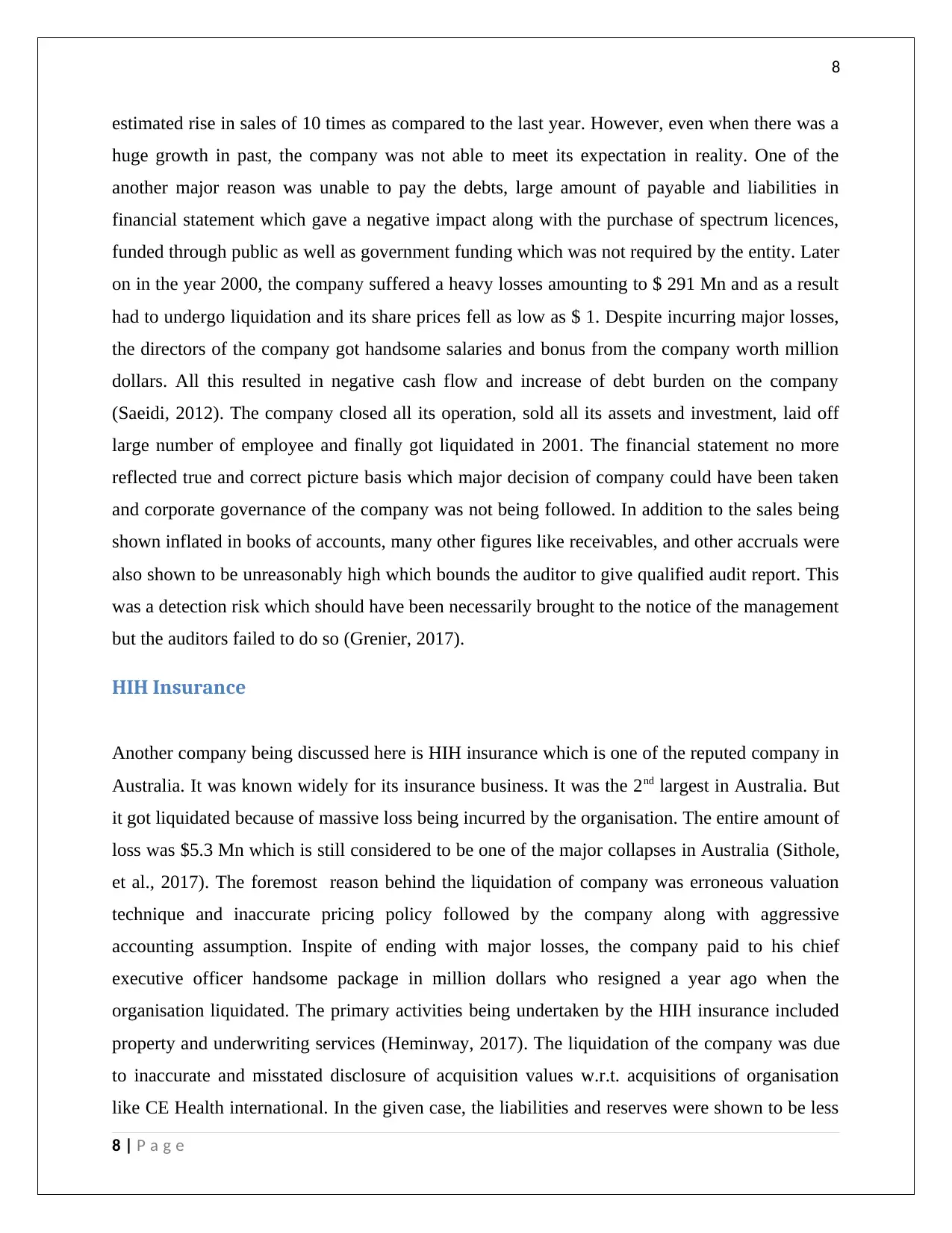
8
estimated rise in sales of 10 times as compared to the last year. However, even when there was a
huge growth in past, the company was not able to meet its expectation in reality. One of the
another major reason was unable to pay the debts, large amount of payable and liabilities in
financial statement which gave a negative impact along with the purchase of spectrum licences,
funded through public as well as government funding which was not required by the entity. Later
on in the year 2000, the company suffered a heavy losses amounting to $ 291 Mn and as a result
had to undergo liquidation and its share prices fell as low as $ 1. Despite incurring major losses,
the directors of the company got handsome salaries and bonus from the company worth million
dollars. All this resulted in negative cash flow and increase of debt burden on the company
(Saeidi, 2012). The company closed all its operation, sold all its assets and investment, laid off
large number of employee and finally got liquidated in 2001. The financial statement no more
reflected true and correct picture basis which major decision of company could have been taken
and corporate governance of the company was not being followed. In addition to the sales being
shown inflated in books of accounts, many other figures like receivables, and other accruals were
also shown to be unreasonably high which bounds the auditor to give qualified audit report. This
was a detection risk which should have been necessarily brought to the notice of the management
but the auditors failed to do so (Grenier, 2017).
HIH Insurance
Another company being discussed here is HIH insurance which is one of the reputed company in
Australia. It was known widely for its insurance business. It was the 2nd largest in Australia. But
it got liquidated because of massive loss being incurred by the organisation. The entire amount of
loss was $5.3 Mn which is still considered to be one of the major collapses in Australia (Sithole,
et al., 2017). The foremost reason behind the liquidation of company was erroneous valuation
technique and inaccurate pricing policy followed by the company along with aggressive
accounting assumption. Inspite of ending with major losses, the company paid to his chief
executive officer handsome package in million dollars who resigned a year ago when the
organisation liquidated. The primary activities being undertaken by the HIH insurance included
property and underwriting services (Heminway, 2017). The liquidation of the company was due
to inaccurate and misstated disclosure of acquisition values w.r.t. acquisitions of organisation
like CE Health international. In the given case, the liabilities and reserves were shown to be less
8 | P a g e
estimated rise in sales of 10 times as compared to the last year. However, even when there was a
huge growth in past, the company was not able to meet its expectation in reality. One of the
another major reason was unable to pay the debts, large amount of payable and liabilities in
financial statement which gave a negative impact along with the purchase of spectrum licences,
funded through public as well as government funding which was not required by the entity. Later
on in the year 2000, the company suffered a heavy losses amounting to $ 291 Mn and as a result
had to undergo liquidation and its share prices fell as low as $ 1. Despite incurring major losses,
the directors of the company got handsome salaries and bonus from the company worth million
dollars. All this resulted in negative cash flow and increase of debt burden on the company
(Saeidi, 2012). The company closed all its operation, sold all its assets and investment, laid off
large number of employee and finally got liquidated in 2001. The financial statement no more
reflected true and correct picture basis which major decision of company could have been taken
and corporate governance of the company was not being followed. In addition to the sales being
shown inflated in books of accounts, many other figures like receivables, and other accruals were
also shown to be unreasonably high which bounds the auditor to give qualified audit report. This
was a detection risk which should have been necessarily brought to the notice of the management
but the auditors failed to do so (Grenier, 2017).
HIH Insurance
Another company being discussed here is HIH insurance which is one of the reputed company in
Australia. It was known widely for its insurance business. It was the 2nd largest in Australia. But
it got liquidated because of massive loss being incurred by the organisation. The entire amount of
loss was $5.3 Mn which is still considered to be one of the major collapses in Australia (Sithole,
et al., 2017). The foremost reason behind the liquidation of company was erroneous valuation
technique and inaccurate pricing policy followed by the company along with aggressive
accounting assumption. Inspite of ending with major losses, the company paid to his chief
executive officer handsome package in million dollars who resigned a year ago when the
organisation liquidated. The primary activities being undertaken by the HIH insurance included
property and underwriting services (Heminway, 2017). The liquidation of the company was due
to inaccurate and misstated disclosure of acquisition values w.r.t. acquisitions of organisation
like CE Health international. In the given case, the liabilities and reserves were shown to be less
8 | P a g e
⊘ This is a preview!⊘
Do you want full access?
Subscribe today to unlock all pages.

Trusted by 1+ million students worldwide
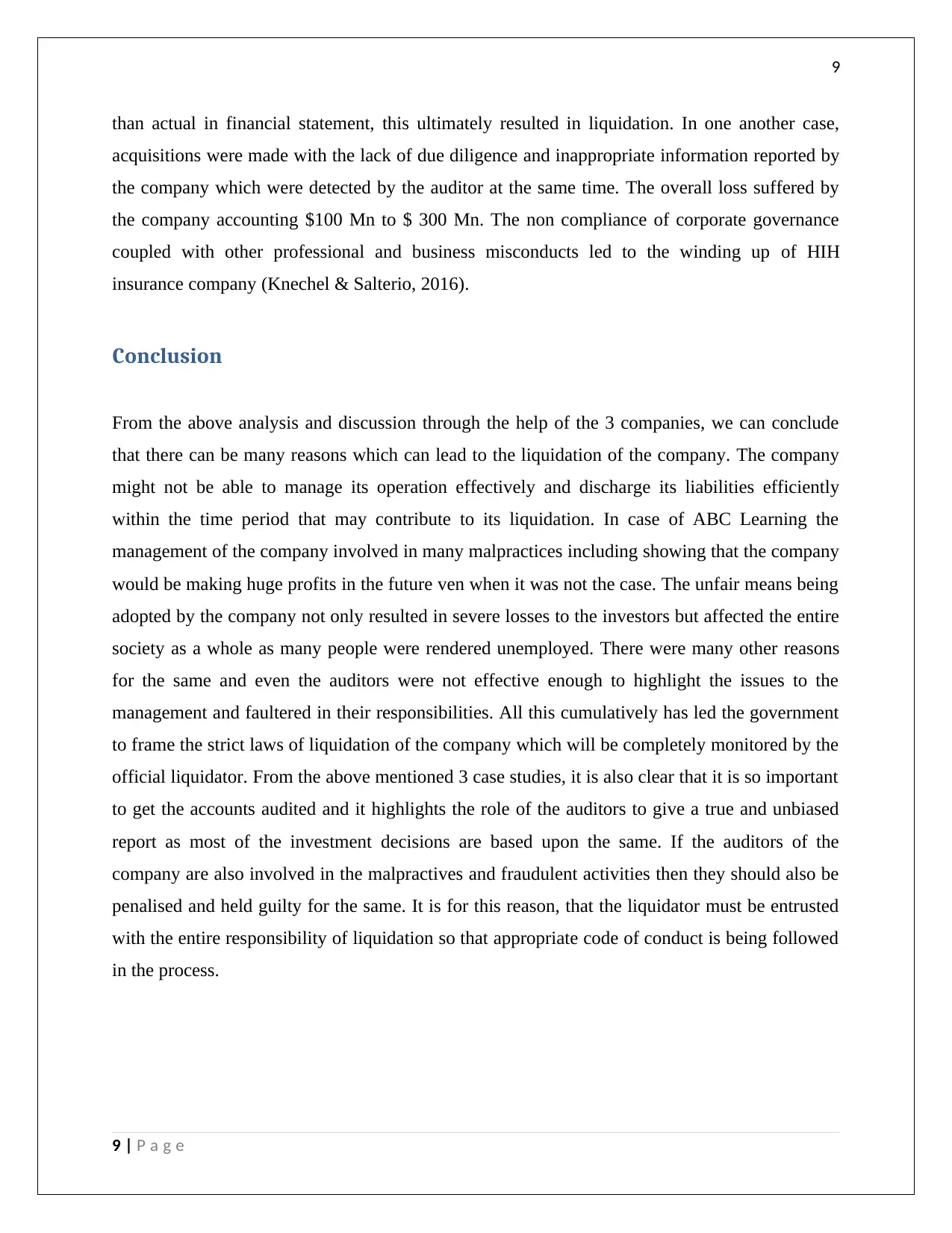
9
than actual in financial statement, this ultimately resulted in liquidation. In one another case,
acquisitions were made with the lack of due diligence and inappropriate information reported by
the company which were detected by the auditor at the same time. The overall loss suffered by
the company accounting $100 Mn to $ 300 Mn. The non compliance of corporate governance
coupled with other professional and business misconducts led to the winding up of HIH
insurance company (Knechel & Salterio, 2016).
Conclusion
From the above analysis and discussion through the help of the 3 companies, we can conclude
that there can be many reasons which can lead to the liquidation of the company. The company
might not be able to manage its operation effectively and discharge its liabilities efficiently
within the time period that may contribute to its liquidation. In case of ABC Learning the
management of the company involved in many malpractices including showing that the company
would be making huge profits in the future ven when it was not the case. The unfair means being
adopted by the company not only resulted in severe losses to the investors but affected the entire
society as a whole as many people were rendered unemployed. There were many other reasons
for the same and even the auditors were not effective enough to highlight the issues to the
management and faultered in their responsibilities. All this cumulatively has led the government
to frame the strict laws of liquidation of the company which will be completely monitored by the
official liquidator. From the above mentioned 3 case studies, it is also clear that it is so important
to get the accounts audited and it highlights the role of the auditors to give a true and unbiased
report as most of the investment decisions are based upon the same. If the auditors of the
company are also involved in the malpractives and fraudulent activities then they should also be
penalised and held guilty for the same. It is for this reason, that the liquidator must be entrusted
with the entire responsibility of liquidation so that appropriate code of conduct is being followed
in the process.
9 | P a g e
than actual in financial statement, this ultimately resulted in liquidation. In one another case,
acquisitions were made with the lack of due diligence and inappropriate information reported by
the company which were detected by the auditor at the same time. The overall loss suffered by
the company accounting $100 Mn to $ 300 Mn. The non compliance of corporate governance
coupled with other professional and business misconducts led to the winding up of HIH
insurance company (Knechel & Salterio, 2016).
Conclusion
From the above analysis and discussion through the help of the 3 companies, we can conclude
that there can be many reasons which can lead to the liquidation of the company. The company
might not be able to manage its operation effectively and discharge its liabilities efficiently
within the time period that may contribute to its liquidation. In case of ABC Learning the
management of the company involved in many malpractices including showing that the company
would be making huge profits in the future ven when it was not the case. The unfair means being
adopted by the company not only resulted in severe losses to the investors but affected the entire
society as a whole as many people were rendered unemployed. There were many other reasons
for the same and even the auditors were not effective enough to highlight the issues to the
management and faultered in their responsibilities. All this cumulatively has led the government
to frame the strict laws of liquidation of the company which will be completely monitored by the
official liquidator. From the above mentioned 3 case studies, it is also clear that it is so important
to get the accounts audited and it highlights the role of the auditors to give a true and unbiased
report as most of the investment decisions are based upon the same. If the auditors of the
company are also involved in the malpractives and fraudulent activities then they should also be
penalised and held guilty for the same. It is for this reason, that the liquidator must be entrusted
with the entire responsibility of liquidation so that appropriate code of conduct is being followed
in the process.
9 | P a g e
Paraphrase This Document
Need a fresh take? Get an instant paraphrase of this document with our AI Paraphraser
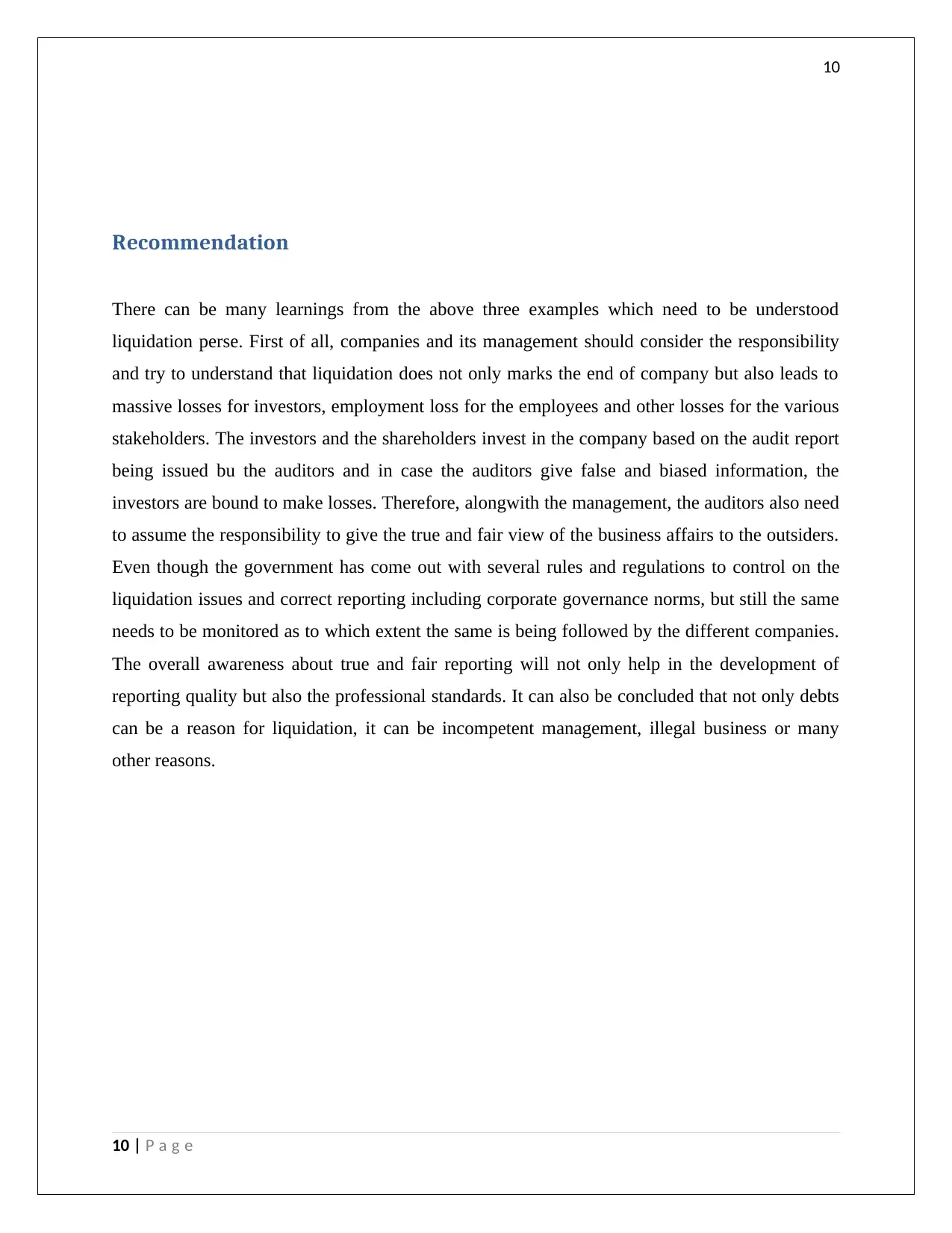
10
Recommendation
There can be many learnings from the above three examples which need to be understood
liquidation perse. First of all, companies and its management should consider the responsibility
and try to understand that liquidation does not only marks the end of company but also leads to
massive losses for investors, employment loss for the employees and other losses for the various
stakeholders. The investors and the shareholders invest in the company based on the audit report
being issued bu the auditors and in case the auditors give false and biased information, the
investors are bound to make losses. Therefore, alongwith the management, the auditors also need
to assume the responsibility to give the true and fair view of the business affairs to the outsiders.
Even though the government has come out with several rules and regulations to control on the
liquidation issues and correct reporting including corporate governance norms, but still the same
needs to be monitored as to which extent the same is being followed by the different companies.
The overall awareness about true and fair reporting will not only help in the development of
reporting quality but also the professional standards. It can also be concluded that not only debts
can be a reason for liquidation, it can be incompetent management, illegal business or many
other reasons.
10 | P a g e
Recommendation
There can be many learnings from the above three examples which need to be understood
liquidation perse. First of all, companies and its management should consider the responsibility
and try to understand that liquidation does not only marks the end of company but also leads to
massive losses for investors, employment loss for the employees and other losses for the various
stakeholders. The investors and the shareholders invest in the company based on the audit report
being issued bu the auditors and in case the auditors give false and biased information, the
investors are bound to make losses. Therefore, alongwith the management, the auditors also need
to assume the responsibility to give the true and fair view of the business affairs to the outsiders.
Even though the government has come out with several rules and regulations to control on the
liquidation issues and correct reporting including corporate governance norms, but still the same
needs to be monitored as to which extent the same is being followed by the different companies.
The overall awareness about true and fair reporting will not only help in the development of
reporting quality but also the professional standards. It can also be concluded that not only debts
can be a reason for liquidation, it can be incompetent management, illegal business or many
other reasons.
10 | P a g e
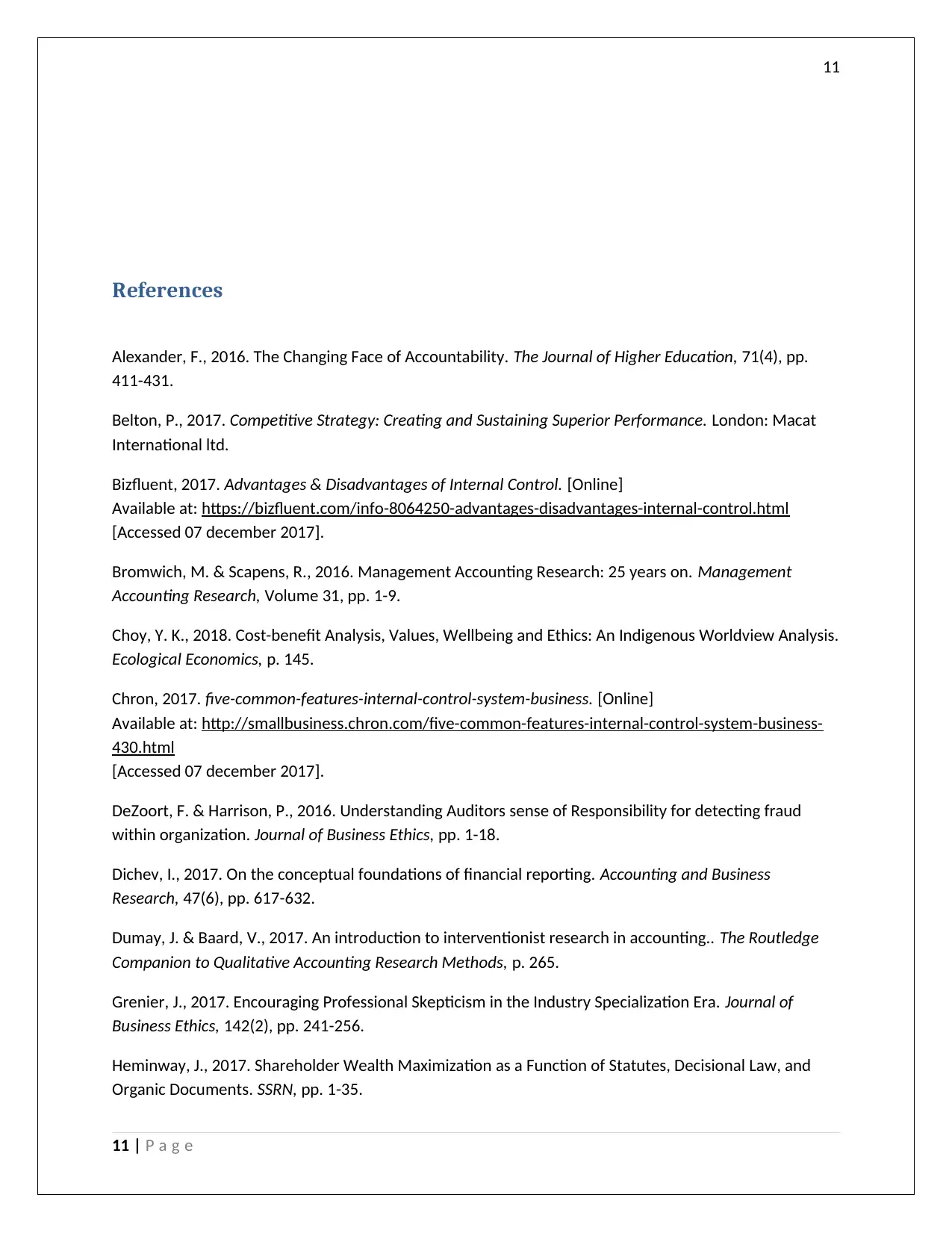
11
References
Alexander, F., 2016. The Changing Face of Accountability. The Journal of Higher Education, 71(4), pp.
411-431.
Belton, P., 2017. Competitive Strategy: Creating and Sustaining Superior Performance. London: Macat
International ltd.
Bizfluent, 2017. Advantages & Disadvantages of Internal Control. [Online]
Available at: https://bizfluent.com/info-8064250-advantages-disadvantages-internal-control.html
[Accessed 07 december 2017].
Bromwich, M. & Scapens, R., 2016. Management Accounting Research: 25 years on. Management
Accounting Research, Volume 31, pp. 1-9.
Choy, Y. K., 2018. Cost-benefit Analysis, Values, Wellbeing and Ethics: An Indigenous Worldview Analysis.
Ecological Economics, p. 145.
Chron, 2017. five-common-features-internal-control-system-business. [Online]
Available at: http://smallbusiness.chron.com/five-common-features-internal-control-system-business-
430.html
[Accessed 07 december 2017].
DeZoort, F. & Harrison, P., 2016. Understanding Auditors sense of Responsibility for detecting fraud
within organization. Journal of Business Ethics, pp. 1-18.
Dichev, I., 2017. On the conceptual foundations of financial reporting. Accounting and Business
Research, 47(6), pp. 617-632.
Dumay, J. & Baard, V., 2017. An introduction to interventionist research in accounting.. The Routledge
Companion to Qualitative Accounting Research Methods, p. 265.
Grenier, J., 2017. Encouraging Professional Skepticism in the Industry Specialization Era. Journal of
Business Ethics, 142(2), pp. 241-256.
Heminway, J., 2017. Shareholder Wealth Maximization as a Function of Statutes, Decisional Law, and
Organic Documents. SSRN, pp. 1-35.
11 | P a g e
References
Alexander, F., 2016. The Changing Face of Accountability. The Journal of Higher Education, 71(4), pp.
411-431.
Belton, P., 2017. Competitive Strategy: Creating and Sustaining Superior Performance. London: Macat
International ltd.
Bizfluent, 2017. Advantages & Disadvantages of Internal Control. [Online]
Available at: https://bizfluent.com/info-8064250-advantages-disadvantages-internal-control.html
[Accessed 07 december 2017].
Bromwich, M. & Scapens, R., 2016. Management Accounting Research: 25 years on. Management
Accounting Research, Volume 31, pp. 1-9.
Choy, Y. K., 2018. Cost-benefit Analysis, Values, Wellbeing and Ethics: An Indigenous Worldview Analysis.
Ecological Economics, p. 145.
Chron, 2017. five-common-features-internal-control-system-business. [Online]
Available at: http://smallbusiness.chron.com/five-common-features-internal-control-system-business-
430.html
[Accessed 07 december 2017].
DeZoort, F. & Harrison, P., 2016. Understanding Auditors sense of Responsibility for detecting fraud
within organization. Journal of Business Ethics, pp. 1-18.
Dichev, I., 2017. On the conceptual foundations of financial reporting. Accounting and Business
Research, 47(6), pp. 617-632.
Dumay, J. & Baard, V., 2017. An introduction to interventionist research in accounting.. The Routledge
Companion to Qualitative Accounting Research Methods, p. 265.
Grenier, J., 2017. Encouraging Professional Skepticism in the Industry Specialization Era. Journal of
Business Ethics, 142(2), pp. 241-256.
Heminway, J., 2017. Shareholder Wealth Maximization as a Function of Statutes, Decisional Law, and
Organic Documents. SSRN, pp. 1-35.
11 | P a g e
⊘ This is a preview!⊘
Do you want full access?
Subscribe today to unlock all pages.

Trusted by 1+ million students worldwide
1 out of 13
Related Documents
Your All-in-One AI-Powered Toolkit for Academic Success.
+13062052269
info@desklib.com
Available 24*7 on WhatsApp / Email
![[object Object]](/_next/static/media/star-bottom.7253800d.svg)
Unlock your academic potential
Copyright © 2020–2025 A2Z Services. All Rights Reserved. Developed and managed by ZUCOL.





